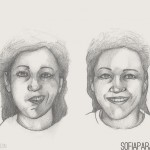Facial palsy is a devastating condition when the patient’s ability to produce a smile is altered and diminished on one or both sides of the face. In addition it can also affect eyebrow movement and lead to asymmetry. Lack of eyelid closure can lead to an inability of the eye to close in a normal way and leave the patient with a very sensitive, teary eye and chronic eye infections.
The condition can be due to a wide variety of causes, such as viral infections that affect the facial nerve (Bell’s Palsy), iatrogenic injury to the nerve or congenital, i.e. some patients are born with a malfunctioning nerve on one or both sides.
Surgical possibilities
A unilateral facial palsy remains one of the great challenges in reconstructive microsurgery. Various procedures are possible to improve function and appearance. Eyebrow asymmetry can be improved with procedures like dermadesis (elevating the eyebrow by removing a piece of skin above the eyebrow) or a unilateral eyebrow lift. The eye itself can be protected by placement of a specially designed gold-weight or closure of the eyelid by performing a canthoplasty. Other options are also available but less commonly used.
To improve the “smile” a two stage procedure using a nerve graft from the healthy side tunneled under the skin to the affected side and then six months later connected through microsurgical techniques to a new muscle imported into the face to replace the non functioning muscles achieves a good result.
This procedure is, however, not suitable for patients over the age of fifty-five. Experience has shown that the ability of the nerve to grow across the face is not optimal after that age. For the older patient group using sling type procedures whereby a graft of tissue from the leg or the transfer of a nearby muscle group to improve static function is used produces the best result.
In cases where both sides of the face are affected it may be possible to connect the new muscle imported into the face to another nerve in the same area (usually the hypoglossal nerve).
Consequences
Depending on the procedure or combination of procedures that you require achieving optimum improvement, the length of the procedure, number of procedures and hospital stay may vary. Most of this kind of surgery is performed under a general anaesthetic.
All surgery results in scarring although well hidden. The chances of success depend on factors individual to your case. Two stage procedures normally involve two operations six months apart.
The first operation takes approximately 2-2.5 hours and you are normally in hospital for two days. The second operation is more complex and lasts approximately 6-8 hours and you are in the hospital for a week. The various sling procedures and those improving the function and appearance around the eye involves surgery lasting approximately two hours and are day cases.
After the surgery
A period of rest is required and the face will be very swollen on the affected side. This can take six weeks and in the cases of importing a new muscle even longer. No heavy exercise should be undertaken for the first four weeks as this may aggravate the swelling and influence the ultimate outcome of the surgery.
Meticulous attention to the incision lines, massaging after a period and sun protection will maximize the appearance. Physiotherapy exercises of the newly transplanted muscle may be helpful once it starts functioning.
Summary
Facial palsy surgery can be very successful in restoring appearance and function but it is important to remember that the procedure suitable for an individual case varies.


